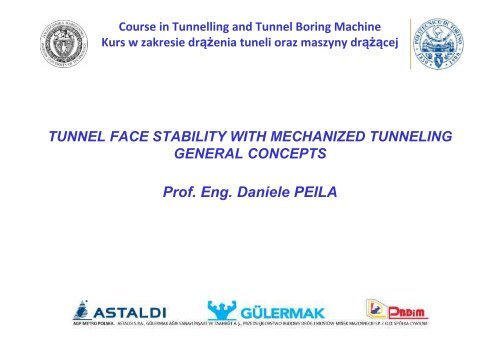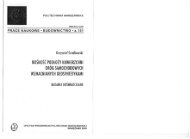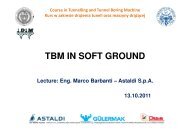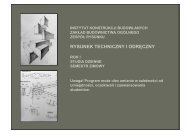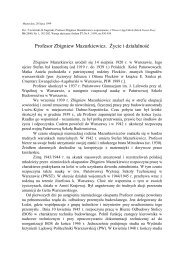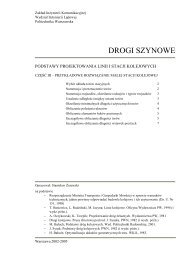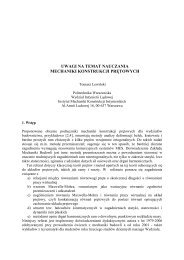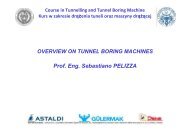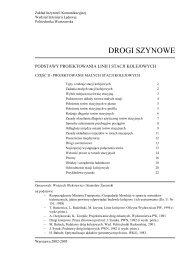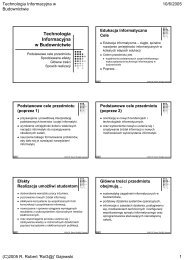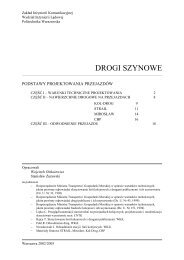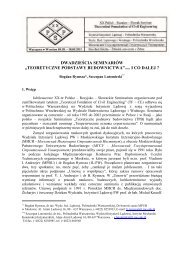TBM face stability control
TBM face stability control
TBM face stability control
You also want an ePaper? Increase the reach of your titles
YUMPU automatically turns print PDFs into web optimized ePapers that Google loves.
Course in Tunnelling and Tunnel Boring MachineKurs w zakresie drążenia tuneli oraz maszyny drążącejTUNNEL FACE STABILITY WITH MECHANIZED TUNNELINGGENERAL CONCEPTSProf. Eng. Daniele PEILA0
<strong>TBM</strong> <strong>face</strong> <strong>stability</strong> <strong>control</strong>When tunneling with full <strong>face</strong> machines in urban areas there are some specificaspects that influence the tunnelling risks and that must be taken into accountin the design and the construction proceduresUrban environmentShallow overburdenStructures on ground sur<strong>face</strong>Foreign objects in groundConstraints for alignmentRestriction for: impossibility of road closure; place of attack, material transport,access to <strong>TBM</strong>, exploration and carring out of auxiliary measures (i.e. groundreinforcements), high visibility of damage1
<strong>TBM</strong> <strong>face</strong> <strong>stability</strong> <strong>control</strong>Geological and hydrogeological conditionsProperties of the recent geological formationsPresence of a man made filling (sometimes of unknown depth)Frequently changing conditionsPresence of ground waterNon – perfect (i.e. not as designed) performance of the tunneling method2
<strong>TBM</strong> <strong>face</strong> <strong>stability</strong> <strong>control</strong>An optimal design must be based on risk analysis and risk management whichmust adddress the decision and chioce to be taken and also influence theconstruction management.In fact this approach permits after the identification of all potentential hazards,to assign to each of them a proability of occurrence and to allocate an index ofgravity-severity to the consequences.With this picture in mind is possible to define:• the solutions to be used to reduce the probability of occurrence of negativeevents;• the measures for reducing the gravity of the consequences of a negativeevent.(Kovari, 2000, 2004; Guglielmenti et al. , 2002; Guglielmetti, Mathab, Xu, 2007)3
<strong>TBM</strong> <strong>face</strong> <strong>stability</strong> <strong>control</strong>The most relevant risk scenarios in urban area when tunnelling with full <strong>face</strong>machines inside a soft soil are:Limiting condition for the machine(that is to say a condition for which the machine is not working as designed)• Eccessive wear of the tools• Eccessive use of conditioning agents, grease, ect.• etc.Interferences with the local enviroment and accidents• <strong>face</strong> collapse which can reach the sur<strong>face</strong>• damage of already existing constructions both on sur<strong>face</strong> orunderground (i.e. subsidence)• Underground water pollution• etc.4
<strong>TBM</strong> <strong>face</strong> <strong>stability</strong> <strong>control</strong>In the present lecture we will analyse the problem of <strong>face</strong> <strong>stability</strong> which cancause the following type of accidents- <strong>face</strong> collapse which can reach the sur<strong>face</strong>- damage of already existing constructions both on sur<strong>face</strong> or underground(i.e. subsidence)TunnelTunnel5
<strong>TBM</strong> <strong>face</strong> <strong>stability</strong> <strong>control</strong>First option for risk reductionThe first set of choices which permit the activation of countermeasures to beadopted to <strong>face</strong> these risk scenarios are :1) the choice of a correct machine for the local urban environment and geology;2) the correct management of the excavation process (<strong>control</strong> of <strong>face</strong> counterpressure,evaluation of the amount of exctracted material to avoidoverexcavations, correct and proper filling of shield body anulus etc.)6
<strong>TBM</strong> <strong>face</strong> <strong>stability</strong> <strong>control</strong>First option for risk reductionWith specific reference to the correct choice and management of the full <strong>face</strong> machinesit is necessary to <strong>control</strong> the <strong>face</strong> <strong>stability</strong>:a) to correctly evaluate the <strong>face</strong> pressure to be applied to guarantee the <strong>stability</strong> andcorrectly apply with reference of the local environment;b) to properly treat (condition) the ground to permit the <strong>face</strong> pressure to be applied bythe machine;c) to <strong>control</strong> the excavation process to avoid over-excavation (monitoring of the groundand of the machine performances)If these options are not sufficients, it is necessary to use a second set of options forrisk reduction.7
<strong>TBM</strong> <strong>face</strong> <strong>stability</strong> <strong>control</strong>Design aspects1) Definition of the stabilizingpressure to guarantee the<strong>stability</strong>2) Definition of the failuremechanism8
<strong>TBM</strong> <strong>face</strong> <strong>stability</strong> <strong>control</strong>Design aspectsThe definition of the appropriate EPB <strong>face</strong> pressure need to be considered on aproject-by-project basis taking into proper account the soil properties, thegroundwater content and the <strong>TBM</strong> design.Groundwater pressure: in some types of rock such as weak or broken rockthe principal reason for using a closed-<strong>face</strong> machine is to <strong>control</strong> groundwater.The operating pressure should be a small margin, perhaps 10%, above theexisting hydrostatic pressure.In water bearing granular material it is necessary to apply operating pressuresto resist both hydrostatic and soil pressure.In both cases it is necessary to ensure that no risk of ground loss from thecrown.(BTS, 2005)9
<strong>TBM</strong> <strong>face</strong> <strong>stability</strong> <strong>control</strong>Design aspectsUnstable ground: in non-water bearing granual material where there is nowater pressure to balance and where the soil pressure may be small it isdifficult to determine the operating pressure.It is necessary to operate the machine at a pressure that ensures the bulkchamber remains full at all the times to guard against loss of ground from thetunnel crown.In soft clays and silts that can flow, it may be appropriate to change fromresisting soil or hydrostatic pressure to a pressure that approximates to fulloverburden pressure(BTS, 2005)10
<strong>TBM</strong> <strong>face</strong> <strong>stability</strong> <strong>control</strong>EPB Soil ConditioningModification or conditioning of the excavated spoil is a process for both slurryand EPB tunnelling system.For EPB shields conditioning agents, usually foam or foam/polymer solution,are injected under pressure into the spoil as it is excavated, to assist thetunnelling process in two ways: When mixed with the soil, the conditioning fluid reduces the permeability andthe internal friction of the material which flow trough the bulk chamber and thescrew conveyor for discharge into the muck-haulage skips at the atmosphericpressure. The reduction of permeability of the material enables the creation of the plugin the screw conveyor to form and ensure that earth pressure balance supportof the tunnel <strong>face</strong> is maintained.11
<strong>TBM</strong> <strong>face</strong> <strong>stability</strong> <strong>control</strong>Stability ControlHDS – version with SLURRY FACESUPORT for soil with no or lowcohesion (gravel, sand, silt) and forground with hard inclusions – fortunneling under groundwater table.EPB – version with FACE SUPPORT BYPRESSURIZED SOIL for cohesiveclayey soil (loam, clay, marl) v- fortunneling below groundwater table.12
<strong>TBM</strong> <strong>face</strong> <strong>stability</strong> <strong>control</strong>Stability ControlMSD – version for “DRY”OPERATION, (if necessary withMACHANICAL FACE SUPPORT –for tunneling through all soilformations above groundwatertable.13
plug in the screw conveyor effect<strong>TBM</strong> <strong>face</strong> <strong>stability</strong> <strong>control</strong>EPB Soil ConditioningEarth pressure distribution diagramExcavation chamber100%Low pressure gradient95%Screw conveyor90%85%80%Injection70%50%0%DischargeEarthPressurePlugareaWithout injectionWith injection100%80%70%50%0%14
<strong>TBM</strong> <strong>face</strong> <strong>stability</strong> <strong>control</strong>Monitoring of buildings and of the sur<strong>face</strong>Torino metro – courtesy GTT-Torino15
<strong>TBM</strong> <strong>face</strong> <strong>stability</strong> <strong>control</strong>Monitoring of machine performanceTo monitor an EPB machine the following parameter are used:- the pressure inside the bulk chamber;- the weigh of extracted material (after the screw drive)Many pressure sensors are applied inside the bulk chamber to measure andkeep under <strong>control</strong> the pressure of the spoil.This <strong>control</strong> is a key parameter for the correct management of the machine andfor the <strong>control</strong> of tunnel <strong>face</strong> <strong>stability</strong>.Guglielmetti et al., 200216
<strong>TBM</strong> <strong>face</strong> <strong>stability</strong> <strong>control</strong>Monitoring of machine performanceAverage value of earth pressure at the<strong>face</strong> and of the weigh of the extractedmaterial.Guglielmetti et al., 200217
<strong>TBM</strong> <strong>face</strong> <strong>stability</strong> <strong>control</strong>Monitoring of machine performanceAverage value of earth pressure at the<strong>face</strong> and of the weigh of the extractedmaterial.Guglielmetti et al., 200218
a) Constructional measures– Ground improvement from the sur<strong>face</strong>– Ground improvement from underground works– Prepared grouted blocks for stopping the machine– Preventive structures<strong>TBM</strong> <strong>face</strong> <strong>stability</strong> <strong>control</strong>Secondary option for risk reductionb) Additional measures– evacuation of buildings– closure of roads19
<strong>TBM</strong> <strong>face</strong> <strong>stability</strong> <strong>control</strong>Ground improvementTorino Metro20
<strong>TBM</strong> <strong>face</strong> <strong>stability</strong> <strong>control</strong>Ground improvementfaldaTorino Metro21
<strong>TBM</strong> <strong>face</strong> <strong>stability</strong> <strong>control</strong>Ground improvementTorino Metro22
Zimmerberg Tunnel<strong>TBM</strong> <strong>face</strong> <strong>stability</strong> <strong>control</strong>Ground improvementZurich; Kovari, 200423
Zimmerberg Tunnel<strong>TBM</strong> <strong>face</strong> <strong>stability</strong> <strong>control</strong>Preventive structuresmicrotunnellingZurich; Kovari, 200424
<strong>TBM</strong> <strong>face</strong> <strong>stability</strong> <strong>control</strong>Prepared grouted blocks for stopping of machinesLongitudinal sectionCross sectiongrouted bodyTunnel25


